10 conclusions from E3 Harelbeke and Gent-Wevelgem
Thomas comes of age, Etixx still strong, the Cancellara and Boonen era








Geraint Thomas comes of age
No rider has personified Team Sky’s Classics improvements more than Geraint Thomas this season. The Welshman is a rider that encapsulates everything the squad’s cobbles contingent embodies, with a balance of talent, poise, and development that have led to number of eye-catching performances.
Thomas’ weight loss, coupled with his growing experience have been documented factors, but it’s the rider's new-found steely determination and confidence that really shines through and made the difference in Haralbeke. Twelve months ago one would have justifiably seen Thomas as looking strong in the event but missing the authority to take the race his riders before a customary crash, puncture or lack of concentration leading to poor positioning. That was Greg Van Avermaet and Fabian Cancellara this year, with Thomas first closing a dangerous gap on the Paterberg before forging clear with Sagan and Stybar on the Kwaremont.
Just like his win in the Commonwealth Games twelve months ago – although this was against a grander backdrop and more accomplished opposition – Thomas took a chance and reaped the due rewards. You can be the strongest in the race – as we’ve seen with Vanmarcke and Sagan on countless occasions – but if you can not measure your efforts and timing, Watts and output tend to count for little when the glare of the press find you at the finish. Thomas is in the form of his life, everything thrown his face is met with the sweetspot of his bat and even the testing deliveries – such as his crash in Gent-Wevelgem - are just about seen off. He has two deliveries to still face in Flanders and Roubaix, and although they’ll be the toughest yet he’s shown what’s needed to handle them. (DB)
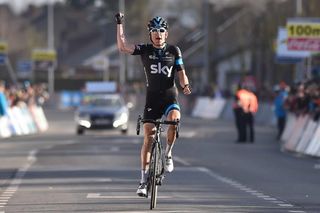
Etixx’s remain the team to beat
There was a collective groan in the press room when Etixx-QuickStep hit the front in Gent-Wevelgem just as Stybar was chasing back on after a puncture. It was as though the team were determined to write their own downfall, or as Bradley Wiggins told Cyclingnews at the start, were synced to race like a rabbit in the headlights without Boonen in their ranks. However ,on the balance of affairs, the Belgian team came away with warranted second places in both E3 Harelbeke and Gent-Wevelgem and they remain a consistent force. In terms of numbers when it matters most, as Servais Knaven told Cyclingnews, ‘they remain the team to beat on the cobbles.’
There is certainly a sense that Lefevere has managed to steady the ship in the absence of Boonen and, with the rider already closing in on the nadir of his career, this campaign could provide Lefevere with the opportunity he needs to address any shortcomings within this squad before a possible winter re-structure. Miss out in Flanders and Roubaix and he has a ready-made excuse, win and he can radiate in beams of his own self-accomplishment.
Get The Leadout Newsletter
The latest race content, interviews, features, reviews and expert buying guides, direct to your inbox!
Winning one from two Monuments is of course easier said than done but it should certainly remain a realistic objective. Terpstra’s move to trace and track the break of favourites in Gent-Wevelgem was as impressive as anything we’ve seen from him since last year’s Paris-Roubaix, and Stybar continues to shine and remains a strong favourite for Flanders. In Nikolas Maes, Matteo Trentin, Stijn Vandenbergh, Iljo Keisse and Guillaume Van Keirsbulck they have an armoury strong enough to hold off almost any challenge, so the question is only whether the team can sew everything together and produce the necessary performance. (DB)
MTN-Qhubeka lacking substance
When the team announced the signings of Edvald Boasson Hagen, Tyler Farrar, and Matthew Goss at the tail-end of last season the MTN-Qhubeka management probably thought that the trio would provide a little more substance than has been delivered so far. On the cobbles of Belgium the team have almost sunk without a trace with their best results: Omloop – 27th (Boasson Hagen), Kuurne 8th (Kristian Sbaragli), Dwars, door Vlaanderen, 42nd (Youcef Reguigui), E3 Harelbeke 19th (Boasson Hagen), Gent-Wevelgem 25th (Gerald Ciolek).
Goss hasn’t managed a top ten all year, Farrar has raced 35 days already but his best result in Belgium was 11th in Le Samyn. And with Boasson Hagen now out with a broken collarbone the team look even less likely to provide a result than at the start of season that began with genuine optimism.
Their three marquee Classics signings came to the team with points to prove but it’s fair to say that the trio had also seen relative decline in their results over the last 18 months. Team Sky no longer wanted to keep Boasson Hagen, and Orica were looking to remove Goss' Milan-San Remo winning wage off their books.
All relatively similar in model and style, one might have expected a result from somewhere as the team loaded their bases but it’s their stage racing team and old hands like Ciolek who continue to keep the ship afloat. (DB)
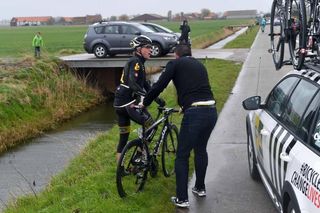
The Sky’s the limit
Up until the start of this season, Team Sky tended to pepper their Classics campaigns with one or two standout performances but there was always lack of consistency simmering under their thin blue line.
Whether it was Stannard winning Omloop Het Nieuwsblad, Eisel in E3 or Flecha in Paris-Roubaix, there tended to be something for the team to hang their campaign on but their overall improvements have been thoroughly effective this time around.
The notion of experience has been addressed throughout the last few weeks, with every result the team have picked up – a win in Omloop Het Nieuwsblad, third in Kuurne, a win in E3 Harelbeke and third in Gent-Wevelgem, providing confidence and building momentum. Only Milan-San Remo stands as a blemish in terms of results.
The loss of Boonen and Cancellara is an obvious factor and will be addressed later, we promise, but there’s a growing sense within the Team Sky camp – and it’s palpable every time we talk their riders –that their time is now. Thomas, Stannard, Rowe, Eisel, and to an extent Puccio and Fenn, have formed the nucleus and, depending on your viewpoint, it’s either commendable or inconsistent that the team have poured yearly resources into the stage racing squad while allowing the Classics team to slowly nurture.
The landscape of the Classics is changing, the autumn of icons’ careers are fast approaching, and through the falling leaves and winds of northern Belgian a new force is merging. They are far from the finished article and holes are gaps are appearing with Stannard’s injury and Wiggins’s patchy results but momentum is with Team Sky. They have never had a better chance to win a Monument. (DB)
The end of the Cancellara and Boonen era?
Professional riders, or athletes for that matter, rarely have the foresight or opportunity to step back from the sport when they’re at the peak of their powers or before they are usurped by the next up and coming talent.
Only next year will determine whether the two Classics icons from the last decade have one more fight left in them with injury scuppering their chances this time around. Boonen may not have won a Classic since 2012 but he would have been within the mix this year had he kept upright in Paris-Nice, while Cancellara, even at 80 per cent, is a match for any rider.
However, the pair’s misfortune has opened up the Classics to a raft of riders who have failed to punch through in the last few season. Vanmarcke, Van Avermaet, Thomas, Boom, and Roelandts have all threatened in the past but now find themselves on the front lines. Gent-Wevelgem has to be taken in context from which it was created – an epic race in epic conditions – but the open racing, the fresh challengers and the weaknesses at several major teams has helped create one of the most exciting build ups to the Tour of Flanders in recent years.
Few would begrudge Cancellara and Boonen one last tango in 2016 but until then the focus is on their heirs. (DB)
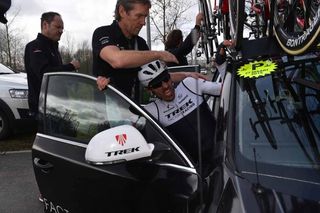
Gent-Wevelgem raises questions about extreme weather protocol
Over the years, extreme weather conditions have made for some of the most memorable moments in classics lore – think Bernard Hinault at Liège-Bastogne-Liège in 1980 or Michele Bartoli at Flèche Wallonne in 1999 – and Sunday’s edition of Gent-Wevelgem is certain to endure as one of the most compelling in its history precisely because of the high winds that buffeted the race.
Yet, the sight of riders being blown off their bikes and into the ditch (or even into the river, in Gert Steegmans’ case) was a disturbing one and raises further questions about the need for an extreme weather protocol to rule when it is safe to race and when it is not. True, a classic is supposed to be hard and the spectacle on Sunday was a gripping one, but at what potential cost?
One imagines that had this not been a spring classic, the peloton might have stopped the race to seek its suspension or even its cancellation, like at the Tour of Oman in February. An informal neutralisation was agreed upon around the 70km mark but, according to Geraint Thomas, that détente was soon broken when Etixx-QuickStep began forcing the pace once again.
Amid the tumult of a Flemish classic, it was inevitable that not everybody would be on the same page, but in the calmer confines of the boardroom, there are no such excuses for the UCI and the riders’ and teams’ associations. (BR)
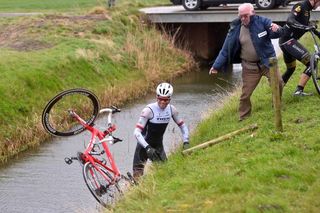
Sagan remains an enigma
Even in his 2013 pomp, when Peter Sagan (Tinkoff-Saxo) arrived at the Belgian classics on a high after a tub-thumping early season, the uneven cobbles of the Oude Kwaremont proved a struggle, so when he cruised across to Geraint Thomas and Zdenek Stybar on the toughest section of the climb at Friday’s E3 Harelbeke, it briefly felt like a great leap forward in his development as a classics rider.
The illusion died quickly, however. When Thomas attacked on the run-in to Harelbeke with four kilometres remaining, Sagan couldn’t muster the strength to lift himself from the saddle and set off in pursuit. He was dropped by Stybar moments later, and was even swept up and spat out by the chasing group in the final kilometre. After the race, Sagan was at a loss to explain his late collapse, though he confirmed that he had not suffered a hunger knock in the finale.
If the finale of Milan-San Remo – where Sagan inexplicably found himself on the front with two kilometres remaining and then poorly-positioned for the sprint – exposed familiar tactical shortcomings, then E3 Harelbeke has raised serious questions about the Slovak’s physical condition just one week shy of the Tour of Flanders.
Two years ago, some observers were placing Sagan on the same exalted level as Fabian Cancellara and Tom Boonen in the hierarchy of classics favourites, yet in their absence this time around, it is telling that expectations around him are decidedly lower.
That might be no bad thing – there is an argument that the pressure of being a favourite contributed to Sagan’s flat showings in last year’s classic – but so far this spring, there have been only the most fleeing glimpses of the effervescence of old. (BR)
Paolini and Kristoff a redoubtable double act
Katusha’s is by no means the strongest squad for the cobbled classics, but surely no team boasts a double act as cohesive as Luca Paolini and Alexander Kristoff. The veteran Italian and the Norwegian fast man’s talents dovetail neatly and – unlike stable-mates on some rival teams – the pair seem to be on the same page tactically at all times.
At Milan-San Remo last weekend, it was Paolini who sacrificed himself for Kristoff, keeping him in contention on the Cipressa, setting the tempo at the front on the Poggio, and then leading him out in the sprint on the Via Roma. At E3 Harelbeke, too, Paolini was generous in his efforts in support of Kristoff, attempting to marshal a chase of the winning break in the finale.
On Sunday, at Gent-Wevelgem, the roles were reversed. The high winds soon made it apparent that a grandstand bunch sprint would not materialise and Kristoff recognised that he was struggling. With 60 kilometres remaining and the winning move already up the road, he gave Paolini his blessing to ride for himself – indeed, it was Kristoff who deftly allowed a gap to open behind Paolini as he accelerated, allowing him to clip off the front of the peloton and give chase alone.
Paolini – somehow – made it across to the leaders and then used all of his guile to slip away for the victory in Wevelgem, while, for good measure, Kristoff claimed the bunch sprint for 9th place despite his earlier travails.
In the absence of an outstanding favourite – ie. in the absence of Boonen and Cancellara – this year’s Tour of Flanders and Paris-Roubaix promise to be open affairs, where a dash of ingenuity could make all the difference. As Sunday showed, Katusha’s pair of aces are not lacking in that department. (BR)
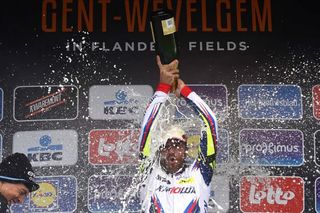
Vanmarcke – Flanders expects
In truth, the weekend told us little about Sep Vanmarcke (LottoNL-Jumbo) that we didn’t already know. As at Omloop Het Nieuwsblad – and all of last spring, in fact – he seemed the strongest on the cobbled climbs at E3 Harelbeke, yet once again he came away with plenty of admiration but no bouquet.
There was mitigation this time around, as a damaged cleat saw Vanmarcke pull a foot come out of his pedal just as he launched his attack on the Paterberg and it later emerged that he had essentially been pedaling with just one leg all the way up the Oude Kwaremont en route to his 5th place finish.
At Gent-Wevelgem on Sunday, Vanmarcke was – not surprisingly – one of the strongmen who forced their way into the winning break with 70 kilometres remaining, though there was a rare moment of weakness on the cobbles when he was almost distanced by Niki Terpstra on the final ascent of the Kemmelberg.
Cancellara’s crash on Friday has seen Vanmarcke installed by many bookmakers as the favourite for the Tour of Flanders, but his failure thus far to turn fine performances on the cobbles into victories must surely be a concern ahead of the big day. Vanmarcke is in a better position than Greg Van Avermaet or Jürgen Roelandts, as unlike them, he already has one a big cobbled win on his palmarès, the 2012 Omloop Het Nieuwsblad. But since then, he has just an array of placings to show for his endeavours, including second at Paris-Roubaix in 2013 and third in Flanders last year.
Asked by Flemish reporters if he had needed a big win before de Ronde to boost his self-belief, Vanmarcke struck a defiant note. “I am confident,” he said. “You’re the ones who are always talking about confidence.”
If Vanmarcke doesn’t land a win on one of the next two Sundays, however, he knows that those questions will only resurface.
Roelandts’ move a sign of things to come?
Jürgen Roelandts and Lotto-Soudal are no strangers to inventive racing on the cobbles. Two years ago, for instance, they showed there was some life in the new Tour of Flanders course by sending riders up the road all day, and were eventually rewarded with Roelandts’ third place finish in Oudenaarde.
On Sunday at Gent-Wevelgem, they made a similar attempt to pull off an improbable heist, by sending Roelandts up the road shortly after the first ascent of the Kemmelberg with almost 50 miles remaining. Whereas at Flanders 2013, Lotto’s aggression was intended to anticipate Fabian Cancellara’s inevitable move in the finale and circumvent a controlled race, Roelandts’ move here was expressly designed to take advantage of a chaotic race where no one team was able to impose its will on proceedings.
It almost paid off. Roelandts opened a gap of more than two minutes over the chasers and – with a tailwind to blow him back to Wevelgem – he must have begun to dream of a spectacular victory. Inevitably, however, he began to tire on the second time up the Kemmelberg, and his brave effort was eventually snuffed out barely ten miles from the line, shortly after passing through the Menen Gate at Ieper.
This windswept edition of Gent-Wevelgem was an extreme case, of course, but in the absence of Tom Boonen and Cancellara, this year’s Tour of Flanders promises to be – in theory at least – a more open affair than it has been to date on the new course to Oudenaarde. The relative impasse behind that followed Roelandts’ attack - and allowed him to build up his lead - won't have escaped the attention of other riders a notch below the very top echelon of favourites. (BR)
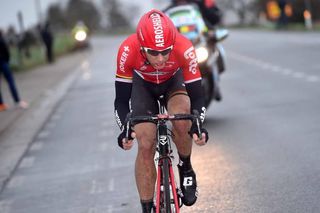

Barry Ryan is Head of Features at Cyclingnews. He has covered professional cycling since 2010, reporting from the Tour de France, Giro d’Italia and events from Argentina to Japan. His writing has appeared in The Independent, Procycling and Cycling Plus. He is the author of The Ascent: Sean Kelly, Stephen Roche and the Rise of Irish Cycling’s Golden Generation, published by Gill Books.
Most Popular



